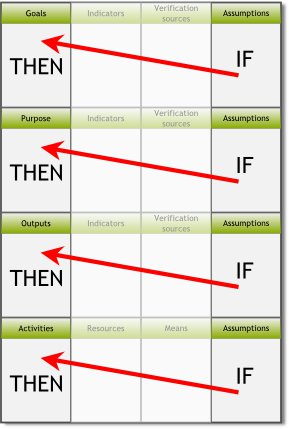What is a logical framework?
The logical framework or logframe is a document that gives an overview of the objectives, activities and resources of a project. It also provides information about external elements that may influence the project, called assumptions. Finally, it tells you how the project will be monitored, through the use of /content/indicators. All this information is presented in a table with four columns and four rows – although variations on this basic scheme do exist.

The vertical logic
The first column of the 4x4 matrix shows the project logic (also called intervention logic) – hence the name logical framework. On the bottom row, you’ll find the project’s activities. When the activities are completed, we expect them to lead to tangible outputs. All the different results together will help to achieve the project’s purpose (sometimes called 'specific objective'). This is the main reason why the project was conceived in the first place. It is the problem that you want to resolve. In a broader context, the project’s purpose will help achieve one or more goals (or 'general objectives'), which you can find in the top row. The term 'project logic' means that one thing leads to another:
- the activities lead to tangible outputs;
- the outputs lead to the project’s purpose;
- the purpose contributes to one or more goals.

But there is also the dimension of time. First we’ll do the activities, which fairly rapidly (in principle as soon as they’re finished) lead to outputs. The realisation of the purpose is further away, at the end or close to the end of the project. The effects or impact of the project is something that we’ll generally notice after a longer period.
The horizontal logic
This first column containing the project logic is about things that are under our control – more or less that is, especially as far as the goals or general objectives are concerned. Jumping directly to the last column, you’ll find the things that are not directly under the project’s control, but that may influence its realisation in a positive or a negative way. These are called assumptions, and they can be found in the fourth column. We speak of assumptions, because when we describe the project’s logic in the first column, we assume that everything goes well. But generally, this is but a mere dream, so we should take precautions to deal with these risks as best as we can. The relationship between the first and fourth column is as follows:
- When we do the activities, and our assumptions hold, we’ll achieve the expected outputs;
- When the outputs are achieved, and our assumptions hold, we’ll realise the project’s purpose;
- When the project’s purpose is attained, and our assumptions hold, we’ll contribute to the listed goals.

To make sure things go as planned and are not disrupted by the potential risks we identified (assumptions) or things we didn’t foresee, we have to set up a system to monitor progress and results. To do so, we use indicators, which can be found in the second column. An indicator is a piece of information we can use to get a (rather accurate) idea of how things are going (a process indicator) or what results have been achieved so far (result indicator).
For instance, if you want to see whether people are well nourished (or under nourished, or even over nourished), you may want to follow up their daily intake of calories. There is more to malnourishment than calorie intake, but it may give you a pretty good idea about how people are progressing. But you may also want to combine several indicators to get a completer picture, for instance to follow up the quality and diversity of the food that people eat.
There is much more to indicators than meets the eye; the art and science of monitoring is a whole field in itself – and is often a reason for much woe and sorrow when designing a logical framework.
Finally, the third column contains the verification sources. They describe where you can find the information of each indicator. Do you measure things yourself or do you ask someone else to do it for you? Or is the information readily available in reports or statistics from other sources?
The logical framework as a document is a tool that is used in many different approaches. It can be used to plan individual projects. It can also be used as a tool to plan, follow-up and evaluate more complex programs that consist of many different individual projects (or actions). And it can be a tool in a complete management approach for organisations. It can be used to plan, or to report, or as a part of a contract. Because of these different roles and different expectations by all the parties that are involved in the project, logframes sometimes have a tendency to become overly complex.